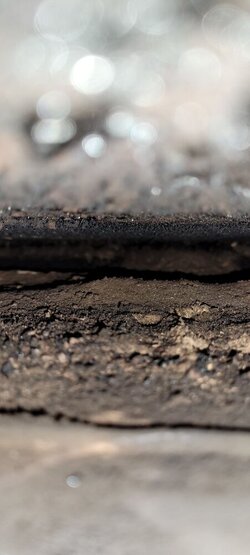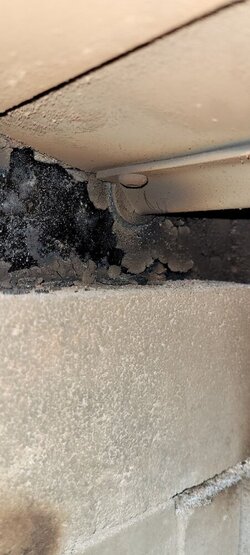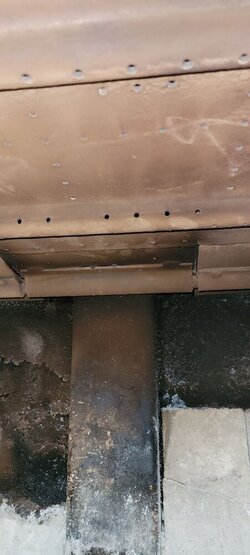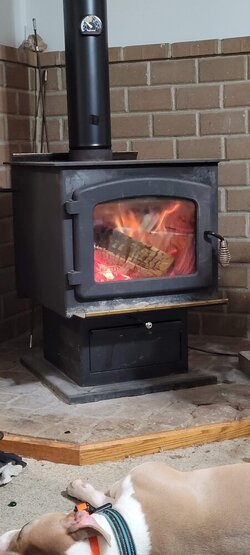Before I start this I'd like to state that I did see the post from user thisoldgoat but I feel my stove may be past what they posted while asking.
Most of the first bits of this are bringing everyone up to speed on my situation here. The actual problem starts at paragraph number 5.
We're purchasing this home from my fathers estate and while it's an unfortunate circumstance, the real issue I'm having is not having the owner around to ask questions about the quirkiness of this stove. I'm unfamiliar with wood burning stoves in general but we have been using it all season with advice from other family members about being careful and whatnot.
Overall we have only had one major issue. We didn't take into consideration that falling creosote would fall on the plate instead of into the firebox and I lightheartedly tapped the flue one day and almost had a fire. Talked to the fire department, learned some stuff, have tried my best to do my due diligence and get much more knowledge. What happened was creosote fell after I tapped it and completely blocked the flue. Then when it started to smolder we called the FD and they came out and cleaned it. The temp dropped back down where the blockage was and they left saying it was all good but despite my warning and trying to explain to them that the creosote is still blocking the flue they just left. We were getting read to leave as the temp had hit nearly room temp when I heard another crackle by chance and I watched the temp start to climb back up in the flue where the creosote was. To fix it since the temp was controllable I took a grinder and pliers to the flue pipe while the wife manned a fire extinguisher. We got a good opening, avoided flames, and mixed the creosote up in the pipe with the extinguisher media for removal. That was the end of this long scary day. No fire actually occurred at any point but needless to say it's scared me good and what made it worse was the realization that the FD had 0 knowledge of these types of stoves and didn't listen to my warnings. But we had also not maintained the flue for 2-3 months. It was entirely operator error and I'll own that dangerous mistake.
A week ago after our situation we replaced the black pipe and decided to fire up our stove (after a full flue cleaning of course and a basic internal stove cleaning). We decided to start as "true first timers" to make sure our maintenance doesn't struggle so that we learn exactly what our schedule needs to be. Learning with the stove I guess instead of just listening to peoples advice. I won't pretend we have the best wood. We're burning white oak right now but it's honestly not the best. It's seasoned but got snowed on all winter long so getting it to dry out is frustrating. I know that the wood is and will continue to be a problem for the time being until we can either get it dry or find some other wood that is already dry. The buildup in the chimney wasn't excessive after a week but it is the hard glazed creosote and we've had smoked glass pretty much daily because we can't keep the stove above 300. It was also a real fight to get the slip connector loose but the rubber glove and twist with my wife and I did the trick. Once it starts going it doesn't smoke much but that's because it seems to just mostly smolder unless we keep the air wide open. Our previous situation was likely enhanced by burning the wood we had. Unseasoned jack pine that had fallen in a storm.
I guess I'm wasting a lot of time with extra stuff but I want to make sure my first post includes information I feel is relevant. Anyways, in the space between the flame plate and the woodstove top there seems to be quite a bit of creosote build up. I don't really have a way to measure it but I'd say a rough estimate is about the thickness of the Rutland thermostat sheet metal. Quite a bit of this from what I can see as well as lots of black fuzzy build up. I don't know my dads maintenance schedule and we plan on having everything inspected and maybe cleaned this spring once the heating season is over but after our little issue with creosote blocking the flue and hitting 900+ at the bottom of the flue I've been quite nervous about every little sound I hear. Is this buildup going to be a problem? If the flue is clear will it comes out eventually or will I need to get in there and scrub it out? I've cleaned flues before and I know the absolute basics of it but I've never worked a stove with this baffle plate in it. The manual is next to useless as it's really just says to make sure the flue is cleaned at a safe interval.
Photos are attached to show the condition of the stove. We know we need some new brick in the rear but I'm hoping to soak up any and all infor I can find on this stove. It doesn't seem to be overly popular.
Unsure of the orientation of this photo but this is inside the flue collar facing the front of the woodstove.

This is a photo of some breakaway buildup near the built in damper lever on the left side of the stove.

Photo of the baffle plate as well as shot of the rear of the stove.

Photo of the stove running at what I would say a decent temperature according to the imperial thermostat.

Most of the first bits of this are bringing everyone up to speed on my situation here. The actual problem starts at paragraph number 5.
We're purchasing this home from my fathers estate and while it's an unfortunate circumstance, the real issue I'm having is not having the owner around to ask questions about the quirkiness of this stove. I'm unfamiliar with wood burning stoves in general but we have been using it all season with advice from other family members about being careful and whatnot.
Overall we have only had one major issue. We didn't take into consideration that falling creosote would fall on the plate instead of into the firebox and I lightheartedly tapped the flue one day and almost had a fire. Talked to the fire department, learned some stuff, have tried my best to do my due diligence and get much more knowledge. What happened was creosote fell after I tapped it and completely blocked the flue. Then when it started to smolder we called the FD and they came out and cleaned it. The temp dropped back down where the blockage was and they left saying it was all good but despite my warning and trying to explain to them that the creosote is still blocking the flue they just left. We were getting read to leave as the temp had hit nearly room temp when I heard another crackle by chance and I watched the temp start to climb back up in the flue where the creosote was. To fix it since the temp was controllable I took a grinder and pliers to the flue pipe while the wife manned a fire extinguisher. We got a good opening, avoided flames, and mixed the creosote up in the pipe with the extinguisher media for removal. That was the end of this long scary day. No fire actually occurred at any point but needless to say it's scared me good and what made it worse was the realization that the FD had 0 knowledge of these types of stoves and didn't listen to my warnings. But we had also not maintained the flue for 2-3 months. It was entirely operator error and I'll own that dangerous mistake.
A week ago after our situation we replaced the black pipe and decided to fire up our stove (after a full flue cleaning of course and a basic internal stove cleaning). We decided to start as "true first timers" to make sure our maintenance doesn't struggle so that we learn exactly what our schedule needs to be. Learning with the stove I guess instead of just listening to peoples advice. I won't pretend we have the best wood. We're burning white oak right now but it's honestly not the best. It's seasoned but got snowed on all winter long so getting it to dry out is frustrating. I know that the wood is and will continue to be a problem for the time being until we can either get it dry or find some other wood that is already dry. The buildup in the chimney wasn't excessive after a week but it is the hard glazed creosote and we've had smoked glass pretty much daily because we can't keep the stove above 300. It was also a real fight to get the slip connector loose but the rubber glove and twist with my wife and I did the trick. Once it starts going it doesn't smoke much but that's because it seems to just mostly smolder unless we keep the air wide open. Our previous situation was likely enhanced by burning the wood we had. Unseasoned jack pine that had fallen in a storm.
I guess I'm wasting a lot of time with extra stuff but I want to make sure my first post includes information I feel is relevant. Anyways, in the space between the flame plate and the woodstove top there seems to be quite a bit of creosote build up. I don't really have a way to measure it but I'd say a rough estimate is about the thickness of the Rutland thermostat sheet metal. Quite a bit of this from what I can see as well as lots of black fuzzy build up. I don't know my dads maintenance schedule and we plan on having everything inspected and maybe cleaned this spring once the heating season is over but after our little issue with creosote blocking the flue and hitting 900+ at the bottom of the flue I've been quite nervous about every little sound I hear. Is this buildup going to be a problem? If the flue is clear will it comes out eventually or will I need to get in there and scrub it out? I've cleaned flues before and I know the absolute basics of it but I've never worked a stove with this baffle plate in it. The manual is next to useless as it's really just says to make sure the flue is cleaned at a safe interval.
Photos are attached to show the condition of the stove. We know we need some new brick in the rear but I'm hoping to soak up any and all infor I can find on this stove. It doesn't seem to be overly popular.
Unsure of the orientation of this photo but this is inside the flue collar facing the front of the woodstove.

This is a photo of some breakaway buildup near the built in damper lever on the left side of the stove.

Photo of the baffle plate as well as shot of the rear of the stove.

Photo of the stove running at what I would say a decent temperature according to the imperial thermostat.


